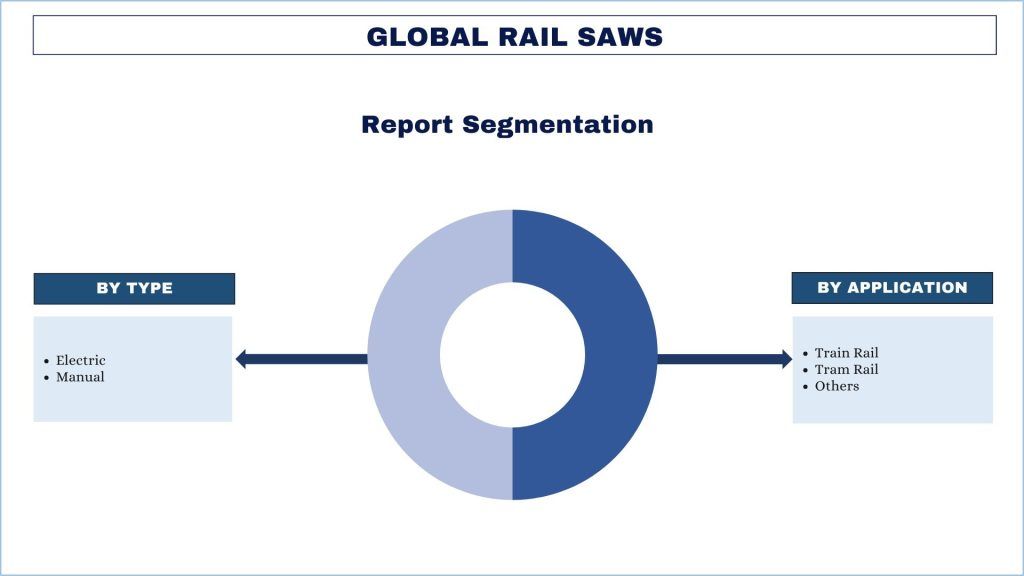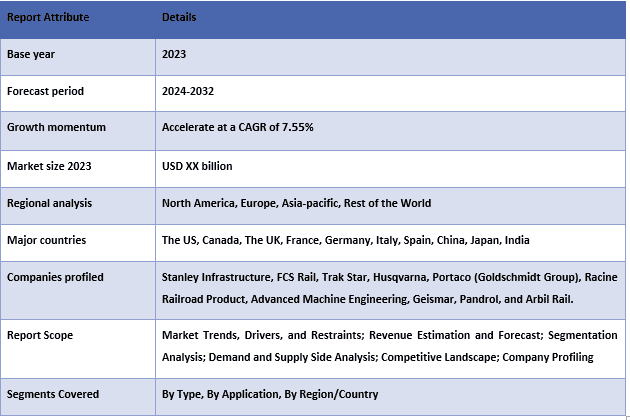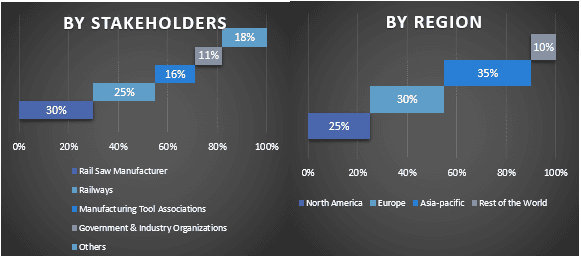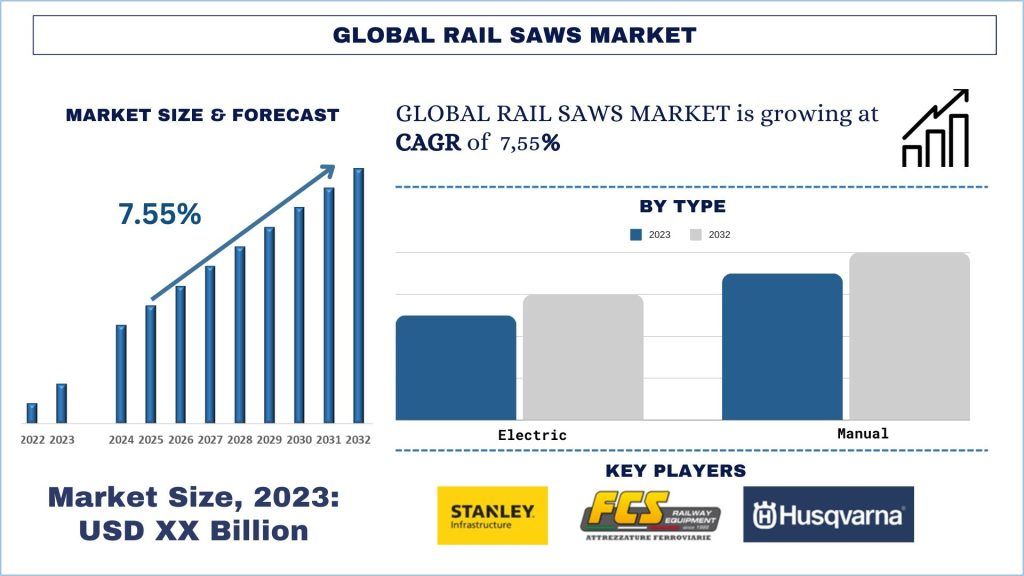レールソー市場:現状分析と予測(2024年~2032年)
タイプ別(電気式、手動式)、用途別(鉄道、路面電車、その他)、および地域別(北米(米国、カナダ、北米のその他地域)、欧州(ドイツ、英国、フランス、イタリア、スペイン、欧州のその他地域)、アジア太平洋(中国、日本、インド、アジア太平洋のその他地域)、世界のその他地域)に重点を置いています。
世界のレールソー市場規模と予測
世界のレールソー市場は、2023年にXX億米ドルと評価され、世界中の鉄道業界におけるレールソーの需要の高まりにより、予測期間(2024年~2032年)中に約7.55%の強いCAGRで成長すると予想されています。
世界のレールソー市場分析
レールソーは、鉄道が行うメンテナンスおよび建設関連の作業に使用される特殊な切断工具です。鋼、コンクリート、複合材料などの様々な種類の材料が、レールソーを用いて切断されます。研磨材ベースのブレードや、ダイヤモンド切断ベースのレールソーなど、様々な種類のレールソーが、鉄道インフラのメンテナンスに使用されています。これらのレールソーは、世界中の鉄道網の安全性、信頼性、寿命に貢献しています。
世界のレールソー市場は、2023年にXX億米ドルと評価され、予測期間(2024年~2032年)中に約7.55%の強いCAGRで成長すると予想されています。レールソーは、完璧な取り付けのために鉄道線を切断したり、鉄道インフラ建設に使用される様々な材料を切断したりするために使用される重要な機器の1つです。この建設ツールの需要は、鉄道インフラを拡大する必要性が高まっているため、近年大幅に増加しています。例えば、2022年、アラブ首長国連邦とオマーンは、総額30億米ドルの国境を越える鉄道線を建設する契約を締結しました。
さらに、様々な鉄道インフラ開発プロジェクトも発表されており、建設機器の需要につながるでしょう。例えば、アフリカ開発銀行は、エジプトの鉄道インフラの改善と拡大のために、1億4500万ユーロの融資を承認しました。
様々な国における鉄道インフラの拡大に対する政府の政策措置と投資は、建設ツールの需要増加とその使用につながる重要な要因となるでしょう。鉄道インフラの開発と老朽化したインフラのメンテナンスが急速に進むにつれて、レールソーの需要は今後数年間、すなわち2024年~2032年にかけて活発化すると予想されます。

世界のレールソー市場の動向
このセクションでは、当社の調査専門家チームが特定した、世界のレールソー市場の様々なセグメントに影響を与えている主要な市場動向について説明します。
鉄道インフラの拡大
都市化の進展と、都市間および都市間通勤を迅速化する必要性の高まりに伴い、世界中で鉄道インフラを改善および拡大する必要性が高まっています。この差し迫った必要性を考慮して、世界の多くの国が、人口増加に対応するために鉄道インフラの拡大に向けて努力しています。例えば、2023年、中国は2,500kmの高速鉄道インフラを建設すると発表しました。中国鉄路はすでに、1,048億米ドル相当の4,100kmの鉄道(うち2,082kmは高速鉄道)を完成させています。
中国、日本、その他のアフリカ諸国など、その他の主要な人口の多い国々も、鉄道インフラの拡大に大規模な投資を行っており、鉄道ソーの需要拡大につながるでしょう。
例えば、トランスカラハリ鉄道および港湾は、1,500kmの鉄道接続プロジェクトの1つであり、著名なプロジェクトです。鉄道および港湾インフラプロジェクトの総推定費用は100億米ドルで、投資され、2025年に完了すると予想されています。
世界中の鉄道インフラプロジェクトへの注目の高まりを考慮すると、鉄道ソーの需要は今後数年間、すなわち2024年~2032年にかけてさらに高まると予想されます。

アジア太平洋地域は予測期間中に主要な市場シェアを保持すると予想されています
アジア太平洋地域のレールソー市場は、世界中で主要な市場シェアを保持しています。成長に貢献した主な要因の1つは、アジア太平洋地域における広大な鉄道線路とインフラの存在です。中国、インド、日本、韓国などの地域における主要国の鉄道インフラの拡大も、顧客体験を向上させるために古い鉄道技術をデジタル化する必要性につながっています。同地域では、多くの高速鉄道プロジェクトが最近完了しており、レールソーのソリューションとサービスの台頭をさらに促進しています。 例えば、2023年、中国鉄路は、天津と北京空港を結ぶ101kmの津興鉄道線を開通させ、4つの駅で構成されています。路線の最高速度は250km/hで、8本の列車が運行されています。
別の例では、2024年に韓国政府が、ソウルとその郊外間の移動時間を短縮するために、高速鉄道を建設する計画を発表しました。グレート・トレイン・エクスプレスと名付けられたこのプロジェクトには995億米ドルの費用がかかり、2035年までに完了する予定です。
アジア太平洋地域における広大な鉄道インフラと、既存のネットワークを電化し、アップグレードする必要性を考慮すると、同地域は今後数年間、すなわち2024年~2032年にかけて、レールソーのグローバル市場を支配すると予想されます。
世界のレールソー業界の概要
世界のレールソー市場は競争が激しく、細分化されており、複数のグローバルおよび国際的な市場プレーヤーが存在します。主要なプレーヤーは、パートナーシップ、契約、コラボレーション、新製品の発売、地理的拡大、合併と買収など、市場でのプレゼンスを高めるために様々な成長戦略を採用しています。市場で活動している主要なプレーヤーには、Stanley Infrastructure、FCS Rail、Trak Star、Husqvarna、Portaco(Goldschmidt Group)、Racine Railroad Product、Advanced Machine Engineering、Geismar、Pandrol、Arbil Railなどがあります。
世界のレールソー市場ニュース
- 例えば、2023年、オーストラリアは総額833億6000万米ドルのメガ鉄道プロジェクトの建設を発表しました。
- 2024年、インド政府は、食料穀物、食料品、肥料、石炭、セメント、鉄、鋼、フライアッシュ、クリンカー、石灰石、POL、コンテナなどの商品の輸送のために、15億米ドル相当の6つのマルチトラッキングプロジェクトを承認しました。
世界のレールソー市場レポートの範囲

このレポートを購入する理由:
- この調査には、認証された主要な業界専門家によって検証された市場規模の測定および予測分析が含まれています。
- このレポートは、業界全体のパフォーマンスの概要を一目で示しています。
- このレポートでは、主要なビジネス財務、製品ポートフォリオ、拡大戦略、最近の開発に焦点を当てて、著名な業界同業者の詳細な分析を取り上げています。
- 業界で普及している推進要因、制約、主要な傾向、および機会の詳細な調査。
- この調査では、異なるセグメントにわたる市場を包括的に網羅しています。
- 業界の地域レベルの分析を深く掘り下げます。
カスタマイズオプション:
世界のレールソー市場は、要件またはその他の市場セグメントに応じてさらにカスタマイズできます。これに加えて、UMIは、お客様が独自のビジネスニーズを持っている可能性があることを理解しています。したがって、お客様の要件に完全に適合するレポートを入手するには、お気軽にお問い合わせください。
目次
世界のレールソー市場分析(2024年~2032年)の調査方法
世界のレールソー市場の過去の市場を分析し、現在の市場を推定し、将来の市場を予測することは、世界の主要地域におけるレールソーの採用状況を作成し分析するために行われた3つの主要なステップでした。過去の市場数値を収集し、現在の市場規模を推定するために、徹底的な二次調査が実施されました。次に、これらの洞察を検証するために、多数の調査結果と仮定が考慮されました。さらに、世界のレールソー市場のバリューチェーン全体にわたる業界の専門家との徹底的な主要インタビューも実施されました。主要なインタビューを通じて市場数値を仮定および検証した後、トップダウン/ボトムアップアプローチを採用して、市場全体の規模を予測しました。その後、市場の内訳とデータ三角測量法を採用して、業界のセグメントとサブセグメントの市場規模を推定および分析しました。詳細な方法論は以下で説明します。
過去の市場規模の分析
ステップ1:二次資料の詳細な調査:
年次報告書と財務諸表、業績プレゼンテーション、プレスリリースなどの企業内部の情報源、およびジャーナル、ニュースと記事、政府刊行物、競合他社の刊行物、セクターレポート、サードパーティのデータベース、およびその他の信頼できる刊行物などの外部の情報源を通じて、世界のレールソー市場の過去の市場規模を取得するために、詳細な二次調査が実施されました。
ステップ2:市場セグメンテーション:
世界のレールソー市場の過去の市場規模を取得した後、主要地域のさまざまなセグメントとサブセグメントの過去の市場の洞察とシェアを収集するために、詳細な二次分析を実施しました。主要なセグメントは、タイプ別およびアプリケーション別にレポートに含まれています。さらに、その地域におけるテストモデルの全体的な採用状況を評価するために、地域/国レベルの分析が実施されました。
ステップ3:要因分析:
さまざまなセグメントとサブセグメントの過去の市場規模を取得した後、世界のレールソー市場の現在の市場規模を推定するために、詳細な要因分析を実施しました。さらに、世界のレールソー市場のタイプ別およびアプリケーション別などの従属変数と独立変数を使用して要因分析を実施しました。世界のレールソー市場セクターにおけるトップパートナーシップ、合併と買収、事業拡大、および製品の発売を考慮して、需要と供給側のシナリオについて徹底的な分析が実施されました。
現在の市場規模の推定と予測
現在の市場規模の算出:上記の3つのステップからの実用的な洞察に基づいて、現在の市場規模、世界のレールソー市場の主要なプレーヤー、およびセグメントの市場シェアに到達しました。必要なすべての割合シェア分割と市場の内訳は、上記の二次的アプローチを使用して決定され、主要なインタビューを通じて検証されました。
推定と予測:市場の推定と予測では、推進要因とトレンド、制約、および利害関係者が利用できる機会を含むさまざまな要因に重みが割り当てられました。これらの要因を分析した後、関連する予測手法、つまり、トップダウン/ボトムアップアプローチを適用して、世界の主要市場におけるさまざまなセグメントとサブセグメントの2032年の市場予測に到達しました。市場規模の推定に採用された調査方法論には、以下が含まれます。
- 収益(米ドル)の観点からの業界の市場規模、および国内の主要市場における世界のレールソー市場の採用率
- 市場セグメントとサブセグメントのすべての割合シェア、分割、および内訳
- 提供される製品の観点からの世界のレールソー市場の主要なプレーヤー。また、急速に成長している市場で競争するためにこれらのプレーヤーが採用した成長戦略。
市場規模とシェアの検証
主要調査:主要な地域のトップレベルのエグゼクティブ(CXO/VP、営業部長、マーケティング部長、オペレーション部長、地域部長、カントリー部長など)を含む主要なオピニオンリーダー(KOL)との詳細なインタビューが実施されました。次に、主要な調査結果が要約され、述べられた仮説を証明するために統計分析が実行されました。主要な調査からのインプットは二次的な調査結果と統合され、それによって情報が実用的な洞察に変わりました。
さまざまな地域における主要な参加者の分割

市場エンジニアリング
データ三角測量法を採用して、市場全体の推定を完了し、世界のレールソー市場の各セグメントとサブセグメントの正確な統計数値に到達しました。世界のレールソー市場におけるタイプ別およびアプリケーション別のさまざまなパラメーターとトレンドを調査した後、データはいくつかのセグメントとサブセグメントに分割されました。
世界のレールソー市場調査の主な目的
世界のレールソー市場の現在および将来の市場動向は、調査で特定されました。投資家は、調査で実施された定性的および定量的分析に基づいて、投資に関する裁量を判断するための戦略的な洞察を得ることができます。現在および将来の市場動向は、地域レベルでの市場の全体的な魅力を決定し、産業参加者が未開拓の市場を利用して、先行者利益から恩恵を受けるためのプラットフォームを提供しました。調査のその他の定量的な目標には、以下が含まれます。
- 世界のレールソー市場の現在および予測される市場規模を、価値(米ドル)の観点から分析します。また、さまざまなセグメントとサブセグメントの現在および予測される市場規模を分析します。
- 調査のセグメントには、タイプ別およびアプリケーション別の領域が含まれます。
- グローバルレールソー業界の規制フレームワークを定義および分析します。
- 業界の顧客と競合他社の行動を分析するとともに、さまざまな仲介業者の存在に関連するバリューチェーンを分析します。
- 主要地域における世界のレールソー市場の現在および予測される市場規模を分析します。
- レポートで調査された地域の主要国には、北米(米国、カナダ、およびその他の北米)、ヨーロッパ(英国、フランス、ドイツ、イタリア、スペイン、その他のヨーロッパ)、アジア太平洋(中国、日本、インド、その他のアジア太平洋)、その他の地域が含まれます
- 世界のレールソー市場の企業プロファイル、および市場プレーヤーが急速に成長している市場で持続するために採用した成長戦略。
- 業界の詳細な地域レベルの分析
よくある質問 よくある質問
Q1:世界のレールソー市場の現在の市場規模と成長の可能性は何ですか?
Q2: グローバルレールソー市場の成長を牽引する要因は何ですか?
Q3: タイプ別では、世界のレールソー市場でどのセグメントが最大のシェアを占めていますか?
Q4: どの地域が世界のレールソー市場を支配するでしょうか?
関連 レポート
この商品を購入したお客様はこれも購入しました











